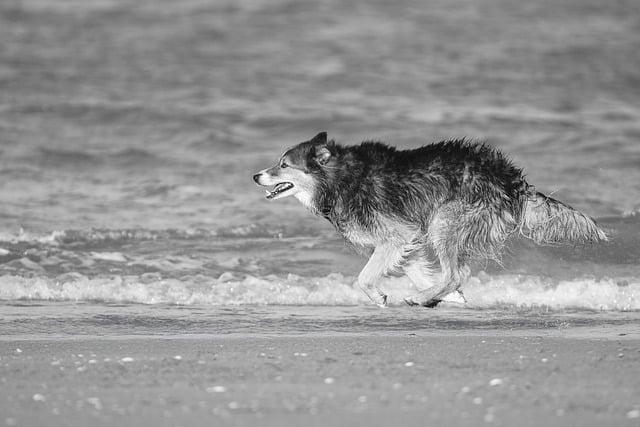When Max, a lively golden retriever, suddenly stopped wagging his tail and began hiding under the couch, his owner Sarah felt a pang of worry. Was it just a phase, or was something more serious at play? As days passed, Max’s disinterest in play and food deepened, prompting Sarah to seek help. This story serves as a reminder: changes in your dog’s behavior can signal underlying issues. Don’t wait for a crisis—if your furry friend seems off, consult a veterinarian. Early intervention can make all the difference in their health and happiness.
Contents
- Understanding Normal Canine Behavior and When It Becomes Concerning
- Identifying Signs of Stress and Anxiety in Your Dog
- Recognizing Aggressive Behavior and Its Triggers
- Seeking Professional Help: When to Consult a Veterinarian or Behaviorist
- Q&A
Understanding Normal Canine Behavior and When It Becomes Concerning
Understanding your dog’s behavior is crucial for fostering a healthy and happy relationship. Dogs, like humans, exhibit a range of behaviors that can be classified as normal. These behaviors include wagging their tails when excited, barking to communicate, and even digging as a natural instinct. Recognizing these typical actions helps you appreciate your dog’s personality and needs. However, it’s essential to differentiate between normal behavior and signs that may indicate underlying issues.
There are several behaviors that, while common, can signal that something is amiss. For instance, if your dog suddenly becomes overly aggressive or fearful, it may be a sign of stress or anxiety. Other concerning behaviors include:
- Excessive barking or whining – This can indicate distress or a need for attention.
- Changes in eating habits – A sudden loss of appetite or overeating can be a red flag.
- Destructive behavior – Chewing furniture or digging excessively may point to boredom or anxiety.
- Withdrawal from social interaction – If your dog is hiding or avoiding contact, it may be feeling unwell.
Another critical aspect to consider is the context of your dog’s behavior. A once-friendly dog that becomes aggressive towards strangers or other pets may be experiencing fear or discomfort. Similarly, if your dog starts to exhibit obsessive behaviors, such as chasing its tail or fixating on shadows, it could indicate a mental health issue that requires attention. Understanding the triggers behind these behaviors is vital for addressing them effectively.
Monitoring your dog’s behavior over time can help you identify patterns and changes that warrant concern. If you notice any significant shifts in your dog’s demeanor or habits, it’s advisable to consult with a veterinarian or a professional dog trainer. Early intervention can make a substantial difference in your dog’s well-being and can help you maintain a harmonious relationship. Remember, being proactive about your dog’s behavior not only enhances their quality of life but also strengthens the bond you share.
Identifying Signs of Stress and Anxiety in Your Dog
Understanding your dog’s behavior is crucial for their well-being. When your furry friend is feeling stressed or anxious, they may exhibit a range of signs that can be easily overlooked. It’s essential to be vigilant and recognize these behaviors early on to ensure your dog receives the care they need. Some common indicators include:
- Excessive barking or whining: If your dog suddenly becomes more vocal, it may be a sign of distress.
- Changes in appetite: A dog that is anxious may eat less or show disinterest in food altogether.
- Destructive behavior: Chewing furniture or digging can indicate that your dog is trying to cope with their anxiety.
- Withdrawal or hiding: If your dog is seeking solitude more than usual, it could be a sign of stress.
Physical symptoms can also manifest when a dog is under stress. Keep an eye out for any changes in their body language or physical health. Signs such as:
- Excessive panting: If your dog is panting heavily without physical exertion, it may be feeling anxious.
- Trembling or shaking: This can be a clear indicator of fear or stress.
- Changes in grooming habits: Over-grooming or neglecting grooming can signal emotional distress.
- Tail position: A tucked tail often indicates fear or anxiety.
Behavioral changes can also be a significant red flag. If your dog is suddenly acting differently, it’s important to take note. Look for:
- Aggression: If your normally friendly dog becomes aggressive, it could be a sign of fear or anxiety.
- Increased clinginess: Dogs that are anxious may seek constant reassurance from their owners.
- Inappropriate elimination: Accidents in the house can indicate stress, especially if your dog is house-trained.
- Hyperactivity: An anxious dog may exhibit restlessness or an inability to settle down.
Recognizing these signs is the first step in addressing your dog’s stress and anxiety. If you notice any of these behaviors persisting, it’s essential to consult with a veterinarian or a professional dog trainer. They can help you determine the underlying causes and suggest effective strategies to alleviate your dog’s anxiety, ensuring they lead a happy and healthy life.
Recognizing Aggressive Behavior and Its Triggers
Understanding your dog’s behavior is crucial for maintaining a harmonious relationship. Aggressive behavior can manifest in various forms, such as growling, snapping, or biting. Recognizing these signs early can prevent potential incidents and help you address underlying issues. Pay close attention to your dog’s body language, as it often communicates their emotional state. Signs of aggression may include:
- Stiff body posture – A tense stance can indicate discomfort or readiness to defend.
- Raised hackles – This can signal excitement or fear, often preceding aggressive actions.
- Direct eye contact – Staring can be a challenge or a sign of dominance.
- Snarling or growling – Vocalizations are clear warnings that your dog is feeling threatened.
Identifying the triggers that lead to aggressive behavior is equally important. These triggers can vary widely from one dog to another, and understanding them can help you manage your dog’s reactions effectively. Common triggers include:
- Fear or anxiety – Dogs may react aggressively when they feel threatened or cornered.
- Protective instincts – Some dogs may become aggressive when they perceive a threat to their territory or family.
- Frustration – A dog may lash out if they feel restrained or unable to reach something they desire.
- Social interactions – Poor socialization can lead to aggressive responses during encounters with other dogs or people.
Once you recognize aggressive behavior and its triggers, you can take proactive steps to address the issue. Training and socialization are key components in modifying aggressive tendencies. Engaging your dog in positive reinforcement training can help them learn appropriate responses to various situations. Additionally, exposing your dog to different environments, people, and other animals in a controlled manner can reduce anxiety and improve their social skills. Remember, consistency is vital in reinforcing positive behavior and diminishing aggressive reactions.
Seeking Professional Help: When to Consult a Veterinarian or Behaviorist
Recognizing when your dog’s behavior crosses the line from normal to concerning can be challenging. If you notice any of the following signs, it may be time to consult a veterinarian or a certified behaviorist:
- Sudden Changes in Behavior: If your dog suddenly becomes aggressive, anxious, or withdrawn, this could indicate an underlying health issue or emotional distress.
- Excessive Barking or Whining: While some vocalization is normal, persistent barking or whining can signal anxiety, frustration, or even pain.
- Destructive Behavior: Chewing, digging, or other destructive actions can be a cry for help, especially if they occur suddenly or escalate in severity.
- Changes in Appetite or Weight: A significant increase or decrease in appetite or weight can be a sign of medical problems that require immediate attention.
Behavioral issues can stem from a variety of factors, including genetics, environment, and past experiences. If your dog exhibits signs of fear or aggression towards people or other animals, it’s crucial to seek professional guidance. A behaviorist can help identify triggers and develop a tailored training plan to address these issues effectively.
In addition to behavioral concerns, physical health should never be overlooked. If your dog displays symptoms such as lethargy, vomiting, or changes in bathroom habits, a visit to the veterinarian is essential. These symptoms can often be linked to pain or illness, and early intervention can make a significant difference in your dog’s recovery.
Ultimately, trusting your instincts as a pet owner is vital. If something feels off with your dog’s behavior, don’t hesitate to reach out for help. Early intervention not only improves your dog’s quality of life but also strengthens the bond you share. Remember, seeking professional help is a proactive step towards ensuring your furry friend’s well-being.
Q&A
- What signs indicate my dog is in distress?
- Excessive barking or whining
- Changes in appetite or drinking habits
- Unusual aggression or fearfulness
- Withdrawal from social interactions
- When should I consult a veterinarian?
- If behavioral changes persist for more than a few days
- When your dog exhibits signs of pain or discomfort
- If there are sudden changes in behavior without an obvious cause
- When your dog engages in self-harming behaviors
- How can I differentiate between normal and concerning behavior?
- Normal behavior includes occasional mood swings and playfulness.
- Concerning behavior is consistent and affects your dog’s quality of life.
- Monitor for patterns; sudden changes are often a red flag.
- Consider environmental factors that may be influencing behavior.
- What steps can I take to address my dog’s behavior?
- Establish a consistent routine for feeding and exercise.
- Provide mental stimulation through toys and training.
- Consult a professional dog trainer or behaviorist if needed.
- Keep a journal of your dog’s behavior to identify triggers.
understanding your dog’s behavior is crucial for their well-being. If you notice persistent changes or signs of distress, don’t hesitate to consult a veterinarian. Early intervention can make all the difference in ensuring a happy, healthy life for your furry friend.

大家好,我是彼得潘,專業的手法身體治療師。我喜歡探索和研究各種主題,並透過與人工智慧的合作分享專業、實用、有趣的文章。我們定期進行人工審核,以確保內容的準確性。如果您發現文章中有任何不準確的地方,請隨時與我們聯繫,我們會及時糾正。您可以透過 [email protected] 與我們聯繫。



